Meal Prep For Work Seasonal Produce For Maximum Flavor
Get ready to transform your work meals with our ultimate guide to meal prep using seasonal produce. Find practical tips and strategies for flavorful, stress-free eating.
There’s a quiet magic in biting into a strawberry that actually tastes like summer or crunching into apples that sing of autumn. When ingredients are picked at their peak, they bring flavors so vibrant they transform ordinary dishes into something extraordinary.
I’ve spent years refining lunch strategies for harried weekdays, and one truth stands out: Planning around nature’s calendar isn’t just romantic—it’s practical. Think carrots that stay crisp all week or tomatoes that burst with juice without added dressings. These small wins add up to lunches that excite rather than exhaust.
Key takeaways:
- Peak-ripeness ingredients pack more taste and nutrients
- Local sourcing preserves texture and freshness longer
- Rotating items keeps your menu interesting and budget-friendly
Busy schedules demand simplicity, but that doesn’t mean sacrificing quality. By aligning your kitchen rhythm with what’s growing nearby, you’ll create grab-and-go options that feel indulgent without the hassle. Let’s explore how to make this work—even on your most chaotic days.
Why Seasonal Produce Matters for Meal Prep
Imagine slicing into a peach so juicy it dribbles down your chin—that’s the power of timing. Foods harvested in their prime don’t just taste better; they work better in your weekly cooking plans.
Flavor That Follows the Calendar
Local farms deliver ingredients at their nutritional peak. A summer tomato ripened outdoors contains up to 30% more vitamin C than greenhouse varieties. This freshness translates directly into morning omelets or grain bowls that need minimal seasoning.
The Freshness Advantage
Consider these comparisons:
| Seasonal | Off-Season | |
|---|---|---|
| Vitamin Content | Higher | Lower |
| Flavor Intensity | Rich | Muted |
| Cost | Budget-friendly | Premium pricing |
I once made the same basil pesto recipe in January and July. The summer version tasted like a different dish—brighter, more complex. That’s the magic you can’t replicate with out-of-season herbs.
Morning routines benefit most. Try swapping imported berries for autumn pears in your oatmeal. You’ll notice sustained energy from breakfast through afternoon meetings. Rotating ingredients keeps your go-to recipes exciting without overhauling your meal system.
Meal Prep for Work Seasonal Produce: Strategies for the Busy Professional
Picture this: It’s 7 AM, and your lunchbox is ready without last-minute chaos. The secret? Treating your kitchen like a backstage area—everything prepped and waiting in the wings.
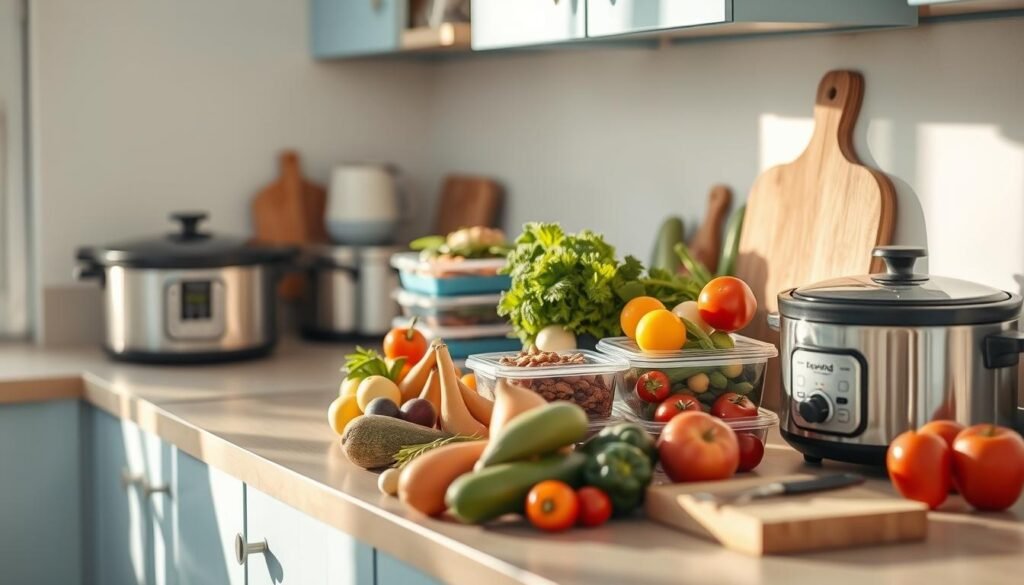
Sync Your Kitchen with Your Calendar
Start with a Sunday reset. Roast two sheet pans of autumn veggies while answering emails. Simmer a big pot of lentil soup during evening calls. These multitasking moments create grab-and-go options that align with nature’s freshest offerings.
Try this 3-step system I use with clients:
- Batch-cook bases (grains, roasted veggies) on low-energy days
- Pre-portion proteins and dressings in stackable containers
- Keep washed greens ready for last-minute assembly
Last November, a nurse client told me:
“Pre-cooked squash soup in mason jars changed my 6 AM shifts. I add kale right before leaving—hot lunch in 90 seconds.”
When meetings bleed into lunch breaks, keep these lifesavers handy:
- Freezer-friendly chili with seasonal beans
- Pre-chopped crudité with almond butter dip
- Individual soup portions labeled with dates
Remember: Flavor thrives in simplicity. A five-minute morning omelet with pre-sautéed mushrooms beats a sad desk salad. Your future self will thank you.
Seasonal Produce: Transitioning from Spring to Winter
My cutting board tells a story through the year—crisp asparagus in April, jewel-toned squash in October. Adapting your lunch routine to nature’s shifts keeps flavors lively while respecting ingredients’ natural rhythms.
Spring and Summer Meal Ideas
Warmer months beg for dishes that celebrate freshness. Try massaged kale salads with shaved radishes or quinoa bowls piled high with snap peas. Spring greens like arugula and spinach thrive here—toss them with lemon-tahini dressing for brightness that lasts all day.
Quick-cook methods rule this season:
- Blanch asparagus to maintain crunch
- Grill zucchini for smoky depth
- Fold fresh herbs into yogurt-based dips
“I pack mint and watermelon salads all June—they’re like edible sunshine at my desk,” says Chef Callie.
Fall and Winter Comfort Foods
When frost arrives, swap raw veggies for roasted roots. Caramelized Brussels sprouts or butternut squash soup become flavor anchors. Hearty greens like kale hold up beautifully in simmered dishes—try them in minestrone with white beans.
Cold-weather prep tips:
| Ingredient | Storage | Prep Hack |
|---|---|---|
| Sweet potatoes | Cool pantry | Roast whole for quick mashing |
| Kale | Fridge in damp towel | Remove stems before freezing |
| Beets | Root cellar | Pre-cook for instant salads |
Pro tip: Roast a big batch of winter veggies Sunday night. They’ll become soup bases, grain bowl toppers, or standalone sides all week.
Maximizing Flavor with Fresh, Local Ingredients
The vibrant colors of a farmers’ market stall tell a story of what’s freshest right now. Building relationships with growers and grocers unlocks ingredients that elevate everyday cooking. It’s about more than taste—it’s a rhythm that syncs your kitchen with the land’s natural cycles.

Sourcing Seasonal Produce Locally
Start by visiting markets early. Vendors often save peak-ripeness items for regulars. Check grocery store flyers—they highlight what’s abundant each month. Last June, I found heirloom tomatoes at half-price because they were in surplus.
Consider this comparison:
| In-Season | Out-of-Season | |
|---|---|---|
| Cost | $2.99/lb | $5.50/lb |
| Flavor | Sweet, complex | Mild, watery |
| Texture | Firm | Soft |
Chat with vendors. Ask, “What’s at its best this week?” They’ll share insider tips. One farmer taught me to grill chicken with summer peaches—a combo I now crave yearly.
- Join CSA programs for curated monthly boxes
- Track harvest calendars for your region
- Sniff melons and berries for ripe sweetness
Buying local strengthens community food networks. Every dollar spent at markets keeps 3x more money circulating locally compared to chain stores. That kale in your salad? It might fund a neighbor’s new greenhouse.
“Regulars get first dibs on limited batches,” says Maria, a Tennessee grower. “We text them when rare herbs or heirloom beans drop.”
Prioritize firmness in veggies and fragrant stems in herbs. These small choices create lunches that taste like they’re from a boutique café—not your Tupperware.
Time-Saving Meal Prep Techniques for Busy Professionals
Wednesday’s lunch rush doesn’t stand a chance against a well-stocked fridge. The secret? Strategic shortcuts that turn 15-minute prep into five days of flavor-packed options.
Start with sauce. Whisk together lemon-tahini or smoky romesco in batches—these liquid gold recipes transform roasted veggies or grains instantly. A client recently shared:
“My mason jar of ginger-scallion sauce dresses three salads and two noodle bowls. Game-changer.”
Egg muffins become your weekday heroes. Mix beaten eggs with spinach and roasted peppers, bake in muffin tins, then freeze. Grab two with whole-grain toast for breakfast or slice them into wrap fillings.
Try these time-tested hacks:
- Slow-cooker Sundays: Simmer chili while answering emails
- Pre-portion snack packs during evening downtime
- Roast two sheet pans of veggies for cross-recipe use
An elementary teacher told me her best way to streamline: “I cook quinoa and roast sweet potatoes simultaneously—they become bowls, salads, or taco fillings all week.”
Play with variations. Swap egg muffins for frittata slices. Turn leftover sauce into marinades. The goal isn’t perfection—it’s creating a rhythm that makes nourishing choices the easiest option.
Practical Meal Planning for Work Environments
Your morning alarm blares, and you need fuel that powers through back-to-back meetings. Smart planning turns rushed mornings into seamless routines where breakfast and lunch practically pack themselves.
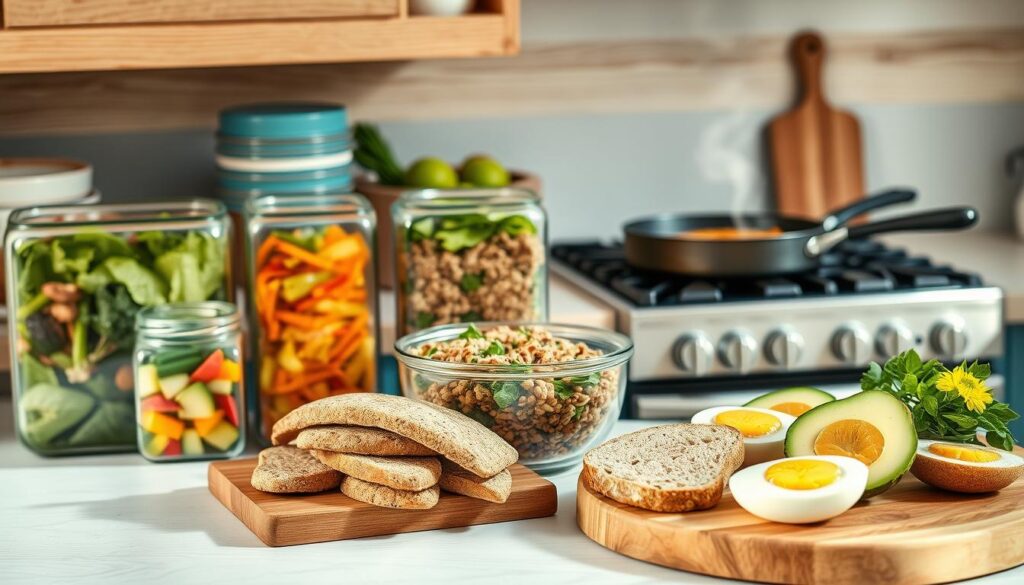
Quick Breakfast Solutions
Overnight oats become your ally. Layer rolled oats with almond milk, chia seeds, and frozen berries in mason jars—they’ll soften overnight into a grab-and-go feast. Hard-boiled eggs offer portable protein: Cook a dozen Sunday night, then pair with pre-sliced avocado or whole-grain toast.
“I keep peeled eggs in a labeled container—my kids grab them while I’m pouring coffee,” says Lena, a high school teacher.
Efficient Lunch Assembly
Build lunches like a sandwich artist. Start with pre-prepped bases: quinoa, roasted sweet potatoes, or massaged kale. Add colorful veggies (think bell peppers or snap peas) and lean proteins like grilled chicken or chickpeas. Cherry tomatoes add juicy brightness without soggy textures.
| Breakfast | Lunch | |
|---|---|---|
| Time Saver | Overnight oats | Pre-chopped veggie kits |
| Protein Source | Greek yogurt | Rotisserie chicken |
| Flavor Boost | Cinnamon | Lemon-tahini dressing |
Layer textures for excitement: Crunchy cucumbers against creamy hummus, or warm roasted tomatoes atop chilled greens. Pre-portion ingredients in stackable containers—you’ll assemble vibrant plates in minutes. Need inspiration? Explore these balanced lunch combinations that turn desk meals into highlights.
Remember: A diced vegetable stash and protein-packed staples transform chaotic days. When your fridge works like a well-oiled machine, you’ll conquer deadlines without compromising flavor or nutrition.
Nutrient-Rich Recipes for Flavorful Work Meals
Monday mornings don’t have to mean frantic kitchen scrambles. With two foundational recipes, you’ll build a rotation of grab-and-go options that keep your energy steady and taste buds engaged.
Morning Fuel That Adapts to You
Overnight oats become your secret weapon. Combine rolled oats, chia seeds, and almond milk in jars—then layer with frozen berries or cinnamon-spiced apples. Top with crunchy almonds before heading out. The beauty? Customization creates endless variety without extra effort.
Egg muffins shine for savory lovers. Whisk eggs with spinach and roasted red peppers, bake in silicone tins, then freeze. Reheat two with whole-grain toast for a protein-packed start. A client shared:
“I make three flavor batches every Sunday—my kids fight over the bacon-kale version!”
Smart Twists for Lasting Appeal
Keep lunches exciting with these swaps:
- Swap oats for quinoa in savory breakfast bowls
- Add shredded zucchini to egg mixtures for hidden veggies
- Mix cooked soba noodles into lunch salads
Need inspiration? These balanced lunch combinations turn desk meals into highlights. Rotate dressings and proteins throughout the week to prevent flavor fatigue.
| Prep Day | Breakfast | Lunch Add-On |
|---|---|---|
| Sunday | Oats base + toppings | Pre-chopped veg mix |
| Wednesday | Egg muffins | Cooked soba noodles |
Pro tip: Double your muffin batch and freeze half. They’ll save you during chaotic weeks when cooking feels impossible. With these staples, you’ll enjoy variety without daily kitchen marathons.
Creative Salads, Soups, and Bowls for Workdays
What if your lunchbox became a canvas? Transform humble ingredients into vibrant meals that surprise your taste buds. Let’s break down how to build excitement into every bite.
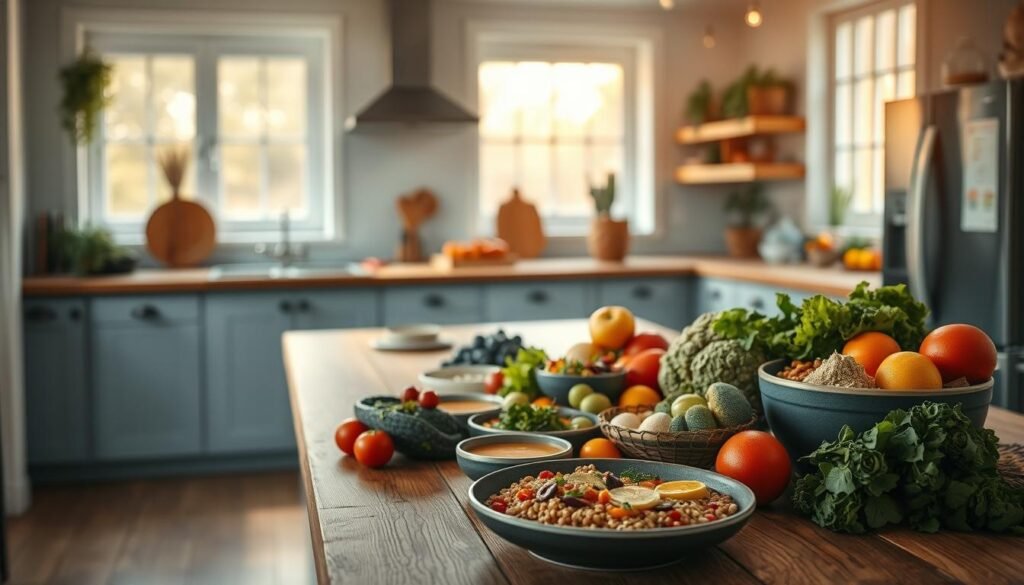
Versatile Salad and Bowl Combinations
Start with a base that adapts. Overnight oats aren’t just for breakfast—mix them with roasted veggies and tahini for a savory twist. Try this formula:
| Base | Texture Boost | Flavor Hero |
|---|---|---|
| Butternut squash cubes | Crunchy pepitas | Maple-dijon drizzle |
| Massaged kale | Crispy chickpeas | Lemon-zest yogurt |
| Cooked farro | Pickled onions | Smoked paprika oil |
Balance sweet and savory. Roasted beets pair beautifully with tart apples, while caramelized onions elevate simple lentil soups stews. A teacher client shared:
“I layer spinach, quinoa, and roasted sweet potatoes in jars—add hot broth at work for instant stew.”
Three rules for memorable bowls:
- Mix temperatures (warm grains + chilled greens)
- Include contrasting textures in every layer
- Use small containers for dressings and crunchy toppings
Don’t underestimate overnight oats as a savory foundation. Combine with roasted garlic, wilted spinach, and a soft-boiled egg for lunch bowls that defy expectations. Soups stews shine when made ahead—their flavors deepen overnight, turning simple ingredients into complex comfort.
Pro tip: Roast a big batch of butternut squash on Sunday. Use it in salads, blend into soups, or mash into grain bowls. Keep experimenting—your perfect combo awaits!
Comforting Warm Meals and Casseroles for Colder Seasons
As frost paints the windows, kitchens become havens for simmering pots and golden-crusted casseroles. These dishes do more than fill lunchboxes—they wrap you in warmth during hectic days. Let’s explore how to harness that cozy magic without spending hours at the stove.
Hearty Soups and Stews
Batch-cooked soups thrive in colder months. A teacher once told me:
“My lentil stew tastes better on Friday than Monday—it’s like flavor alchemy.”
Build depth with caramelized onions or roasted garlic. These ingredients meld beautifully over time, turning simple broths into rich, layered meals.
Try this framework for week-long planning:
- Sunday: Roast root veggies and simmer broth
- Wednesday: Transform leftovers into shepherd’s pie filling
- Friday: Blend extra soup into pasta sauce
Keep textures intact by storing grains separately. Add cooked barley or wild rice just before reheating. For casseroles, layer spinach between sweet potatoes and turkey—it stays vibrant for days.
| Ingredient Swap | Flavor Boost | Prep Tip |
|---|---|---|
| Butternut squash | Smoked paprika | Freeze in muffin tins |
| White beans | Rosemary | Mash for thickener |
| Kale | Lemon zest | Massage before baking |
Embrace the season’s rhythm with dishes that improve over time. A chili made Monday becomes nacho topping by Thursday. That’s the beauty of planning—every simmer pot does double duty.
Diverse Flavor Profiles: Sauces and Dressings to Elevate Your Meals
A well-crafted sauce can turn roasted veggies into a gourmet experience. Think about that lonely sweet potato—drizzle it with sage-brown butter, and suddenly it’s the star of your lunch box. Dressings aren’t just toppings; they’re flavor bridges connecting ingredients.

Homemade Sauce Recipes
Let’s start with a fall classic: maple-cider vinaigrette. Whisk ¼ cup olive oil, 2 tbsp apple cider vinegar, 1 tsp Dijon mustard, and 1 tbsp maple syrup. This balances sweet and tangy—perfect for kale salads with roasted squash.
“I make a double batch every Sunday,” says Derek, a graphic designer. “It transforms my grain bowls into something I actually look forward to.”
Compare store-bought vs homemade options:
| Store-Bought | Homemade | |
|---|---|---|
| Sodium | High | Controlled |
| Flavor Depth | Flat | Layered |
| Cost Per Ounce | $1.50 | $0.75 |
Try these quick ideas:
- Blend roasted garlic into Greek yogurt for a creamy dip
- Infuse olive oil with rosemary for roasted root veggies
- Mix tahini with orange zest as a bright sandwich spread
Herbs are your secret weapon. Fresh thyme pairs beautifully with roasted mushrooms, while dill brightens up lentil salads. Keep dressings in squeeze bottles—they’ll stay fresh all week and make lunch assembly effortless.
Don’t underestimate simplicity. A squeeze of lemon over roasted Brussels sprouts can outshine complicated recipes. Your taste buds—and schedule—will thank you.
Planning a Week of Nutrient-Dense Meals
Sunday’s grocery haul shouldn’t feel like a chess match—yet here we are, staring at kale like it’s our opponent. The solution? A flexible blueprint that turns chaotic ingredients into coordinated nourishment. I’ve cracked the code through years of testing: Map three anchor dishes first, then let leftovers spark creativity.
- Monday-Wednesday: Cook fresh proteins and grains
- Thursday-Friday: Reinvent extras into new dishes
- Weekends: Use remaining veggies in frittatas or soups
A client recently shared:
“Roasted chicken becomes tacos, then chicken salad sandwiches—my kids never notice it’s the same bird!”
Build your days around these pillars:
| Breakfast | Lunch | Dinner |
|---|---|---|
| Overnight oats | Grain bowl with leftovers | Sheet-pan protein + veggies |
| Egg muffins | Upcycled sandwich fillings | Stir-fry with remaining ingredients |
Smart swaps keep taste buds guessing. Turn extra roasted veggies into hummus wraps or blend them into spreads. Day-old grains? Pan-fry them with eggs for savory breakfast bowls.
Remember: Consistency thrives in simplicity. By Friday, you’ll have nourished your body and saved hours—all without a single boring day.
Balancing Work Schedules with Efficient Meal Prep Planning
Juggling conference calls and daycare pickups leaves little room for kitchen marathons. The solution? Treat your fridge like a backstage crew—silently supporting your daily hustle with prepped ingredients ready for their spotlight moment.
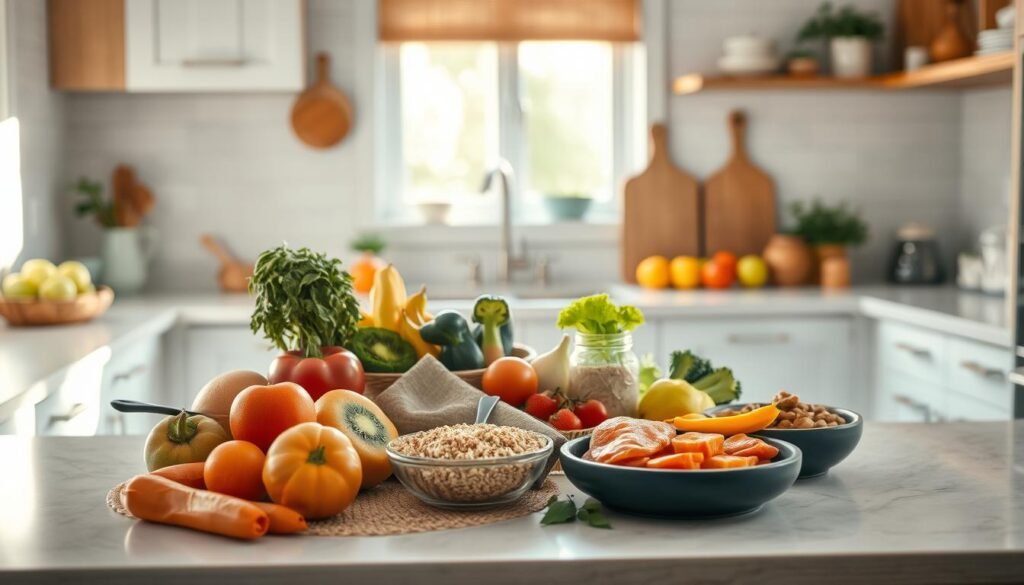
Start with foundation builders. Cook a big batch of rice Sunday night—it becomes stir-fry filler, soup thickener, or salad base. Roast cubed squash alongside; its natural sweetness elevates grain bowls and breakfast hashes. These staples stay fresh for 4-5 days, cutting daily cooking time by half.
Sarah, a pediatric nurse, shared her strategy:
“I layer rice, roasted veggies, and grilled chicken in bento boxes. Each compartment gets a different sauce—teriyaki, pesto, salsa. Feels like takeout without the wait.”
Transform leftovers into new creations. Monday’s salads become Tuesday’s wraps when you add hummus and spinach. Use this rotation guide:
| Base Ingredient | Day 1 | Day 3 |
|---|---|---|
| Rice | Stir-fry | Stuffed peppers |
| Squash | Roasted side | Soup puree |
| Greens | Salad base | Omelet filling |
Keep dressings and toppings separate until serving. A mason jar of lemon vinaigrette prevents wilted greens, while nuts stay crunchy in snack bags. Batch-cook proteins during downtime—hard-boiled eggs or shredded chicken work in salads, tacos, or grain bowls.
Remember: Efficiency thrives on repetition with variation. That squash roasting while you fold laundry? It’ll fuel three different lunches, each feeling freshly made.
Insights from Seasonal Meal Prep and Nutrition Experts
Every lunchbox tells a story—especially when packed with nature’s freshest chapters. Let’s hear from those who’ve turned kitchen routines into vibrant rituals using ingredients at their peak.
Real-World Success Stories
Take Jenna, a third-grade teacher in Oregon. She swapped pre-packaged snacks for roasted root veggie bowls last fall. “My energy stays steady through parent conferences,” she says. “Plus, my students beg for my sweet potato fries!”
“Clients who plan dinner around local harvests report better sleep and focus,” notes Maya Torres, RD. “It’s not just nutrition—it’s connecting with your community’s growing cycle.”
See how small shifts create big impacts:
| Strategy | Before | After 30 Days |
|---|---|---|
| Seasonal bowls | 3x/week | 5x/week |
| Farmers’ market trips | Monthly | Weekly |
| Leftover creativity | Rare | 4 dinners/week |
A Colorado nurse’s team started a lunch swap program. “We share bowls featuring our garden hauls,” she explains. “Thursdays are ‘Try-It’ days—we’ve discovered 12 new veggies this year!”
Nutritionist Liam Chen shares a client win: “They transformed Tuesday dinners into ‘clean-out-the-fridge’ nights. Overripe berries became chia jam, wilting greens turned into pesto. Food waste dropped 60% in two months.”
Ready to start? These spicy grain bowls prove planning can be adventurous. Your story begins with one roasted veggie, one mason jar, one day at a time.
Leveraging Leftovers and Minimizing Food Waste
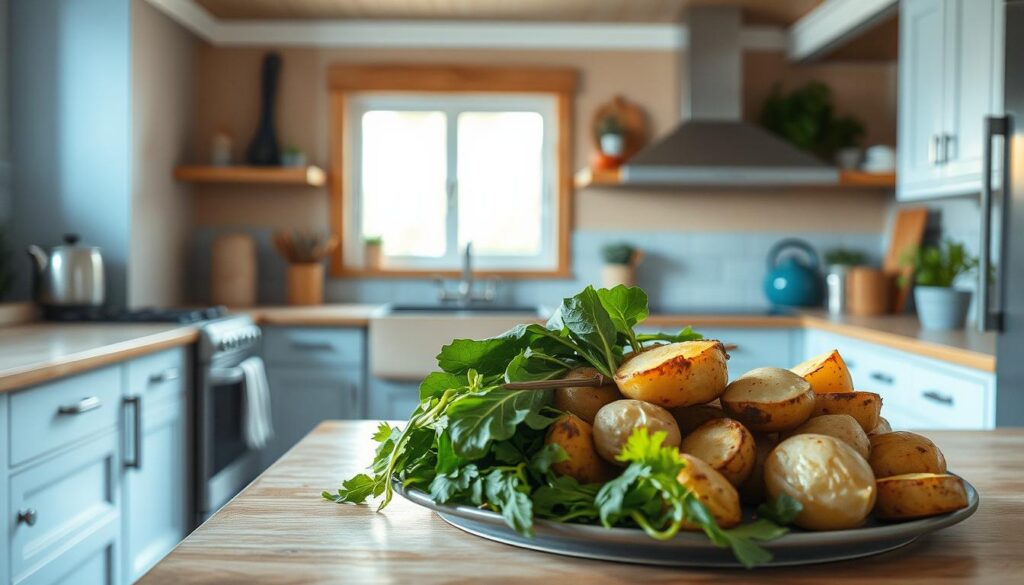
Your fridge holds more potential than you think—those leftover roasted veggies could become tomorrow’s star dish. Let’s unlock their hidden value while keeping your budget and conscience clear.
Start with flavor bridges. Almond butter isn’t just for toast—stir it into oatmeal, thin with vinegar for salad dressing, or mix with soy sauce as a protein glaze. One jar can stretch across breakfast, lunch, and snacks all month.
| Strategy | Before | After | Impact |
|---|---|---|---|
| Roasted veggies | Thrown out | Frittata filling | Saves $15/month |
| Stale bread | Composted | Croutons | Reduces waste 30% |
| Extra grains | Forgotten | Soup thickener | Cuts prep minutes |
A teacher client shared her hack:
“Leftover quinoa becomes breakfast bowls with almond milk and frozen berries. Two minutes in the microwave—boom, weekday fuel.”
Sunday’s roasted chicken does triple duty. Shred it for tacos, simmer bones for broth, then mix remaining meat with mayo and almonds for sandwiches. Fifteen minutes of planning stretches one protein across three days.
Track what gets tossed most. If wilting greens haunt your trash, blend them into pesto instead. Overripe bananas? Freeze for smoothies. Small shifts create big savings—both financially and environmentally.
Remember: Your freezer is a time capsule. Portion leftover chili in muffin tins for instant single servings. Label with dates, and you’ve got emergency meals ready in minutes all month long.
Adjusting Meal Prep to Seasonal Variations and Changing Needs
Your lunchbox shouldn’t wear the same outfit all season. Just like swapping sweaters for tank tops, recipes need refreshing as ingredients shift. A client once confessed, “I used to dread Tuesday lunches until I realized my bowl game could change with the weather.”
Three Rules for Weekly Reinvention
Rotate textures and flavors to keep things exciting. Try these swaps:
| Season | Base | Mix-In | Topping |
|---|---|---|---|
| Spring | Quinoa | Snap peas | Lemon-tahini |
| Fall | Wild rice | Roasted squash | Pepitas |
- Turn Monday’s kale salad into Wednesday’s soup by blending with white beans
- Wrap roasted root veggies in tortillas for burritos instead of usual grain bowls
- Add massaged kale to scrambled eggs for breakfast twists
“I make two versions of every recipe—one with spinach, one with kale. My kids think they’re getting different meals!” —Marisol, preschool director
Need inspiration? Fold autumn apples into breakfast burritos or toss grilled peaches into summer bowls. Small tweaks prevent flavor fatigue while keeping nutrition balanced. Your taste buds—and weekly routine—will thank you.
Your kitchen rhythm can dance with nature’s calendar without complicated choreography. Those mason jars of overnight oats? They’re proof that nourishing choices thrive in simplicity. When we let fresh ingredients lead, every bite becomes an invitation to savor the moment.
Through trial and error—burnt sweet potatoes and all—I’ve learned this truth: Meals built around nature’s schedule deliver flavor and energy. Rotate roasted roots in winter, toss snap peas in spring, and watch your lunchbox transform. One nurse’s squash soup hack became her team’s cold-weather staple—proof that small shifts create lasting impact.
Keep these essentials in your back pocket:
• Batch-cook bases like grains during downtime
• Reinvent leftovers into chili or simmered soups
• Let dressings and sauces become flavor bridges
Your most chaotic days needn’t derail good intentions. A Sunday batch of roasted veggies becomes Tuesday’s grain bowl or Friday’s wrap filling. Those overnight oats? Stir in autumn apples or summer berries for effortless variety.
This isn’t about perfection—it’s progress. Start with one simmered soup or jar of spiced oats. Let each season’s harvest guide your kitchen rhythm. With time, you’ll craft lunches that feel like a warm hug, even on the busiest workdays.
Savory Sweet Corn and Zucchini Breakfast Fritters
These savory fritters combine sweet corn and fresh zucchini into a crispy, golden breakfast treat. Perfect for a weekend brunch or a quick weekday meal, they pair wonderfully with a dollop of Greek yogurt or a spicy yogurt dip.

Nutrition Information
Equipment Needed
- Large mixing bowl
- Grater
- Frying pan
- Spatula
- Measuring cups and spoons
Ingredients
-
1 cup grated zucchini
-
1 cup sweet corn kernels (fresh or frozen)
-
2 eggs
-
1/2 cup all-purpose flour
-
1/4 cup grated Parmesan cheese
-
2 tablespoons chopped fresh chives
-
1/2 teaspoon salt
-
1/4 teaspoon black pepper
-
1/4 teaspoon chili flakes (optional)
-
2 tablespoons olive oil for frying
Instructions
Recipe Video
Sweetcorn Fritters and Yoghurt Dip | Gordon Ramsay
Gordon Ramsay demonstrates how to make spicy, savory sweetcorn fritters accompanied by a refreshing yogurt dip, using simple store-cupboard ingredients.


